High level of violence by Israeli settlers; rise in Israeli fatalities
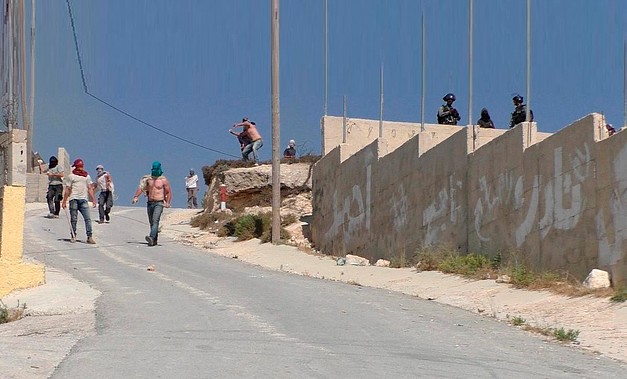
The high level of Israeli settler violence against Palestinians reported during the first four months of 2018 in an earlier Humanitarian Bulletin, continued through October as the annual olive harvest began. Since the start of 2018, OCHA has documented 217 incidents attributed to Israeli settlers that have resulted in Palestinian casualties (60 incidents) or in damage to Palestinian property (157 incidents).[1] As a monthly average, this is the highest level of incidents recorded since 2014 and represents a 57 and 175 per cent increase compared with 2017 and 2016 respectively (see chart).
The most frequent type of incident so far in 2018 involved the vandalizing of trees, crops and other agricultural property (71 incidents); stone-throwing and vandalizing of Palestinian homes and vehicles, including arson (81 incidents); and various forms of physical assault, most of which targeted farmers and herders (35 incidents).
In 2018 three Palestinians were killed by Israeli settlers and 83 were injured, including at least 20 children. In the most recent incident, on 12 October, a 45-year-old Palestinian woman, mother of eight, was killed and her husband injured after being stoned when driving through the Za’atra/Tapuach checkpoint in the northern West Bank. Although the assailants remain unknown, Israeli security sources indicated that there is a “high probability” that they are Israeli settlers.[2] The other two fatalities were a Palestinian boy killed after he stabbed and killed an Israeli settler, and a Palestinian man killed after he reportedly attempted to stab an Israeli settler.[3]
Properties damaged during incidents this year include some 7,200 Palestinian-owned trees and more than 300 vehicles. As in previous years, the majority of the trees vandalized were olive trees. However, there has been a significant increase in the targeting of grapevines, with a total of 12 incidents resulting in damage to over 2,300 vines. For example, on 23 May, unknown assailants cut 440 grapevines planted from five to 35 years ago on four dunums of land next to Road 60 near Halhul village (Hebron), and sprayed “price tag” and offensive graffiti in Hebrew on rocks nearby; the damage was estimated by the Palestinian Ministry of Agriculture at over $177,000.
Monthly average of incidents leading to Palestinian casualties or property damage
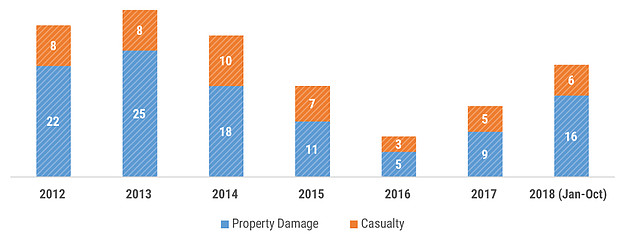
Palestinian access to some cultivated areas requires authorization (also known as ‘prior coordination’) with the Israeli authorities on the grounds that these are ‘areas of friction’. Approximately 90 Palestinian communities own land within or in the vicinity of 56 Israeli settlements and settlement outposts where ‘prior coordination’ is required. These areas are designated as ‘closed military zones’ and access is permitted only to Palestinian owners during specific times, mostly during the olive harvest and ploughing seasons. Although these procedures have the stated aim of protecting Palestinians farmers and their property, 26 of this year’s settler attacks resulting in casualties or property damage were recorded in areas requiring ‘prior coordination’.
Nablus governorate continues to be the region most affected by settler violence, accounting for 40 per cent of incidents in 2018 (86 incidents), the majority in areas surrounding the settlement of Yitzhar and its adjacent outposts.[4] Nablus is followed by Hebron and Ramallah governorates with 17 and 16 per cent of incidents, respectively. One of the hotspots in Ramallah governorate is the settlement outpost of Adei Ad, identified as the source of at least eight attacks primarily affecting farmers from Turmusayya village.
Clashes with Israeli forces
The figures cited above exclude incidents of settler raids in Palestinian localities and entries to religious sites there, which did not result in casualties or damage by the settlers themselves: many of these incidents generated friction between settlers and Palestinians that triggered the intervention of Israeli forces and subsequent clashes with local residents.
Since the start of 2018, there have been 37 settler raids/entries triggering clashes with Israeli forces that resulted in the death of two Palestinians and 446 injured (see case study for details of the latest fatality in October 2018). The average number of clashes per month with Israeli forces following settler raids/entries has increased significantly in 2018 compared with previous years.
Palestinian attacks on Israeli settlers and other Israeli civilians
Since the start of 2018, OCHA has recorded a total of 144 Palestinian attacks against Israeli settlers and other Israeli civilians in the West Bank resulting in casualties or damage (based on Israeli media reports). As a monthly average, this is 33 per cent lower than in 2017 (21 incidents per month).
Despite the decline in the number of incidents, fatalities among Israeli settlers and other civilians increased in 2018: seven people were killed in the first ten months of 2018 compared with three in all of 2017. The latest fatal attack took place on 7 October, when a Palestinian man employed in the industrial area of Barkan settlement shot and killed an Israeli man and woman, also injuring another woman.
Some of the peaks in settler violence against Palestinians recorded this year occurred within two or three days immediately after the killing of Israeli settlers by Palestinians and were presumably in retaliation.
Palestinian injuries by Israeli forces following settler raids/entries by locality, January-October 2018
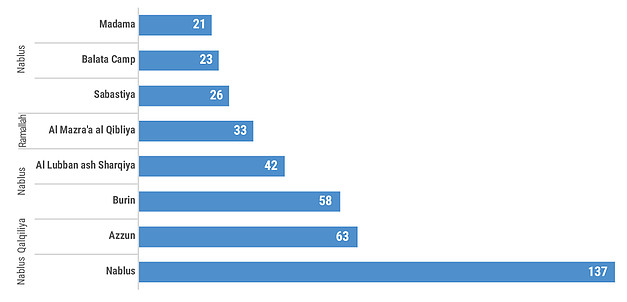
Other settler incidents during this period included the vandalizing of cars and the spraying of offensive graffiti. These have been attributed by some media reports to a practice known as “price tag”, which aim to exact a price from Palestinians for the removal, by the Israeli authorities, of structures in settlement outposts. Since the beginning of 2018, a number of removals and evictions took place in small settlement outposts associated with radicalized young settlers in Nablus governorate.[5]
Gaps in accountability
As the occupying power, Israel has the obligation to protect Palestinian civilians from all acts or threats of violence, including by Israeli settlers, and to ensure that attacks are investigated effectively and perpetrators held accountable. The failure to do so has been a longstanding concern of the humanitarian community in the OPT and is believed to contribute to the persistently high levels of settler violence.
In a report issued in October 2018, the Israeli Ministry of Justice (MoJ) stated: “In recent years, Israeli authorities made considerable efforts to enhance law enforcement in the West Bank, which […] included the establishment of designated taskforces, increased allocation of funds, and the addition of professional manpower.”[6] According to the report, between January and July 2018, the Israeli police opened a total of 35 investigations related to settler violence against Palestinians, of which four led to the indictment of suspects, four were closed and the rest are still ongoing.
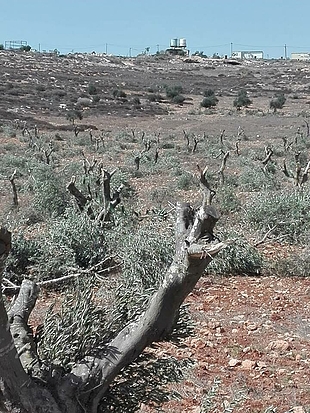 According to the Israeli human rights organization Yesh Din, of 185 investigations monitored by the organization which were opened between 2014 and 2017 and reached a final stage, only 21, or 11.4 per cent, led to the prosecution of offenders, while the other 164 files were closed without indictment.[7] The equivalent rate of indictment for the period 2005-2013 was 7.5 per cent (73 of 978 investigations).
According to the Israeli human rights organization Yesh Din, of 185 investigations monitored by the organization which were opened between 2014 and 2017 and reached a final stage, only 21, or 11.4 per cent, led to the prosecution of offenders, while the other 164 files were closed without indictment.[7] The equivalent rate of indictment for the period 2005-2013 was 7.5 per cent (73 of 978 investigations).
Concerns about lack of accountability exist with regard to both attacks on Palestinians and their property, and also to the takeover of Palestinian private and public (or ‘state’) land by settlers. Law enforcement against takeovers has been minimal, and in most cases required extensive litigation in the Israeli courts. In recent years the Israeli authorities adopted several policies to retroactively legalize (under Israeli law) the takeover of Palestinian land.
Since 2011, at least 29 unauthorized settlement outposts built on land classified by the Israeli authorities as public land have been retroactively issued with building permits, or are in the process of being authorized. In January 2017, the Israeli Parliament passed a law allowing the expropriation of private Palestinian land, which was taken over and built on by settlers, provided that they had received explicit or implicit support from the authorities; the implementation of the law has been frozen by the Israeli Supreme Court following petitions challenging its legality under international law and Israeli (constitutional) law.
Official endorsement by the Israeli authorities of the illegal takeover of Palestinian land by settlers has two main ramifications with regard to settler violence. First, this policy has enabled the entrenchment and growth of settlement outposts, some of which have been a cosistent source of attacks against Palestinians.[8] Secondly, official endorsement appears to promote an atmosphere of impunity, which may also contribute to settler violence.
Settler violence and settlement expansion
The establishment and continuous expansion of settlements is a key driver of humanitarian vulnerability. It deprives Palestinians of their property and sources of livelihood, restricts access to services, and creates a range of protection threats that, in turn, have triggered demand for assistance and protection from the humanitarian community.
A series of case studies published in this Humanitarian Bulletin between November 2016 and February 2017 indicated that, in at least some instances, settler violence is not random but is a calculated effort towards the de facto expansion of settlements.
The case studies suggest that violence and intimidation, supplemented by various types of access restriction implemented concurrently by both settlers and Israeli forces, have reduced or eliminated Palestinian presence in some areas and facilitated settlement expansion. These restrictions include the deployment of roadblocks and checkpoints; prohibition on the use of roads by Palestinian vehicles; the designation of areas as closed for military purposes or as “nature reserves”; the fencing off of privately-owned Palestinian land; and imposing a ‘prior coordination’ requirement for Palestinian access to farming land.
Settler violence and settlement expansion in western Ramallah
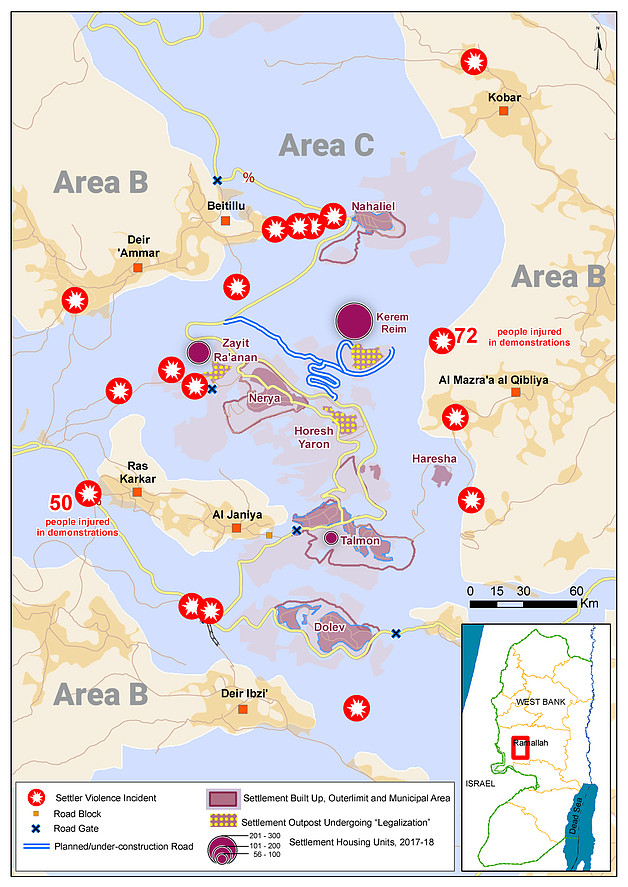
Responding to settler violence
Settler violence undermines the physical security and livelihoods of Palestinians in various parts of the West Bank. Humanitarian actors seek to respond by providing protection and other forms of assistance, including for vulnerable groups such as children and women. Humanitarian interventions include the deployment of a protective presence in high-risk areas; psychosocial support to victims; the installation of protective infrastructure; documentation of cases; legal counselling; and livelihood support.
For example, Première Urgence Internationale, an NGO providing assistance and protection in the West Bank, recently repaired a road in Burin (Nablus), a community particularly affected by settler violence from outposts surrounding Yitzhar settlement. The original road that connected six families residing on the outskirts of Burin with the rest of the village was precarious and unsuitable for cars, leaving the families more vulnerable when settler attacks occur. The renovation has facilitated rapid access to the area by other residents during a settler attack, and enabled the rapid evacuation of people injured during attacks or subsequent clashes with Israeli forces.
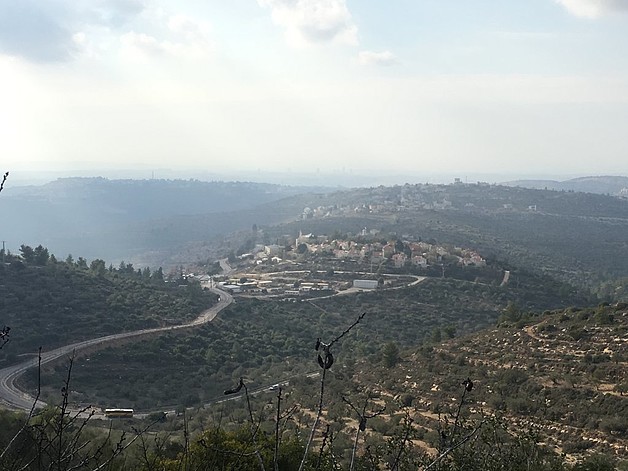
Settler violence and settlement expansion: the case of central Ramallah governorate
The findings of a research study published in the Humanitarian Bulletin issued in December 2016 highlighted the dynamics of de-facto settlement expansion in areas surrounding the Nahliel and Talmon settlements in central Ramallah governorate. The research found that the area controlled by the settlements where Palestinian access is severely restricted or impossible, is almost 2.5 times larger than the official Israeli-designated municipal boundaries of these settlements (15,100 vs 6,200 dunums). According to official Israeli records, over half of the land within these de facto boundaries is privately owned by Palestinians from six nearby villages: Beitillu, Ras Karkar, al Janiya, Deir Ammar, Mazra’a al Qibliya and Kobar, where approximately 20,000 Palestinians live.
In the two years since publication of the study, settlement expansion and de facto control over the area has been further entrenched, alongside sustained levels of violence perpetrated by Israeli settlers against Palestinians and their property. This has had a detrimental impact on the livelihoods and security of Palestinians in the affected communities.
During this period, the Israeli authorities approved planning schemes for three unauthorized residential outposts, established in previous years within the facto boundaries of Nahliel and Talmon, for the construction or retroactive “legalization” of around 460 housing units.[9] Development of water springs in the area as tourist sites has also continued. In one of the five springs taken over by settlers in the past (Ein Misraj on al Janiya village land), several new caravans were installed and a number of incidents were documented involving the harassment of Palestinian farmers in the area. This has further limited the ability of Palestinian farmers and herders to rely on these springs for irrigation and watering of livestock.
Since early 2018, Israeli settlers began opening, without building permits or formal authorization, two new roads on land belonging to residents of Mazra’a al Qibliya and Ras Karkar villages (see map): work on the former was subsequently halted following a court order, while construction on Ras Karkar land is ongoing. During the latter work, settlers took over some 10 dunums of land and planted it with approximately 500 olive saplings.
These developments have prompted regular protests in both villages, many of which evolved into clashes with Israeli forces and settlers. In the latest incident in al Mazra’a al Qibliya on 26 October, a 33-year-old Palestinian was shot and killed by Israeli forces after Israeli settlers raided the village during a demonstration. In total, 118 Palestinians have been injured protests in these two villages since February 2018, including 28 children.
Whilst the immediate trigger of the demonstrations was road construction by Israeli settlers, local residents reported to UNOCHA that the concern is essentially the cumulative trend of land control by Israeli settlers that is gradually swallowing up all of the village’s land.
In the meantime, Palestinian access to areas surrounding Nahliel and Talmon settlements continues to be hampered by settler violence. Since January 2017 OCHA has recorded 23 incidents in this area resulting in either Palestinian casualties or damage to property. Property damage by Israeli settlers included the vandalism of some 220 olive trees and saplings, a water well, and dozens of vehicles; theft of crops; spraying anti-Palestinian graffiti; and throwing stones at Palestinian farmers and houses. Of note, four of the incidents involved raids and vandalism of property in Area B in three of the affected villages (Ras Karkar, al Mazra’a al Qibliya and Kobar).
[1] UN OCHA Financial Tracking Service, visited on 1 November 2018 accessed here
[2] The US has substantially reduced its funding in the OPT, including deciding not to disburse more than $200 million from USAID’s approved budget for the 2017 fiscal year in the West Bank and Gaza, cutting $25 million to the East Jerusalem hospitals network, and, most recently, $10 million to Israeli and Palestinian co-existence groups.
[3] This will be achieved through a three-pronged approach. Firstly, ensuring all communities and key institutions such as schools, early childhood development centres and healthcare facilities, have access to safe drinking water services and domestic water services. Secondly, promoting more sustainable solutions for safe water and sanitation services wherever possible to reduce aid dependency. And thirdly, providing adequate sanitation services jointly with hygiene promotion by providing and/or rehabilitating sanitation facilities for households and key education and social service institutions such as schools, Early Childhood Development centres and healthcare facilities.
[4] Both categories are mutually exclusive. Incidents resulting in both casualties and property damage are classified as resulting in casualties.
[5] A. Harel, Killing of Palestinian Woman in West Bank Increasingly Suspected to Be Jewish Terror Act, Ha’aretz, 26 October 2018.
[6] The first incident took place on 26 July at Adam settlement (Jerusalem governorate) and the second on 8 April near Ma’ale Adumim settlement.
[7] For an in-depth analysis of patterns of violence around Yitzhar settlement, see Yesh Din, Yitzhar – a case study, August 2018.
[8] See for example Elisha Ben Kimon, “Increasing tensions between Israeli security agency and hilltop youth”, Ynet, 17 April 2018 (in Hebrew); Yotam Berger, “Five right wing activists arrested”, Ha’aretz, 31 January 2018.
[9] The outposts are Kerem Reim (previously known as Nahlei Tal), Horesh Yaron and Zeit Ra’anan.









